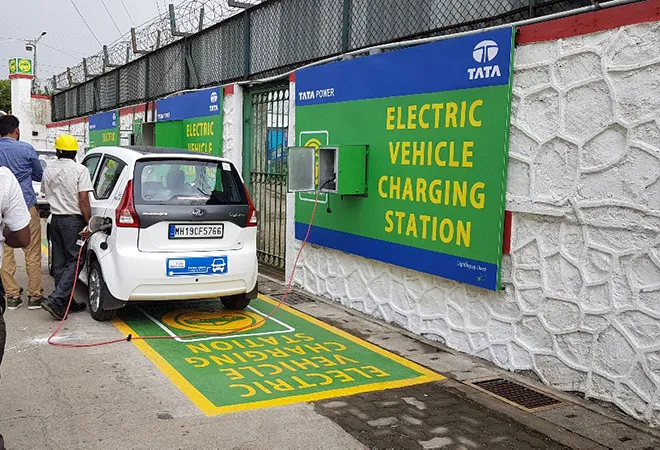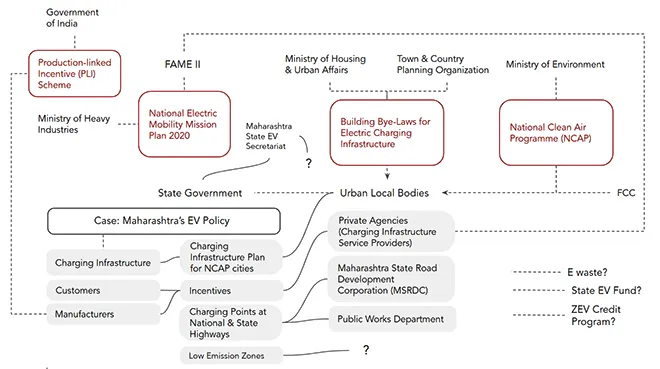
In India, the transport sector contributes an estimated 142 million tonnes of CO2 annually. e-mobility, amongst other solutions to decarbonise transportation infrastructure, has been a focus of the country. In 2013, the National Electric Mobility Mission Plan 2020 was launched to provide the vision and the roadmap for faster adoption of Electric Vehicles (EV) and their manufacturing. The Government of India (GoI) has set ambitious targets for electric mobility in the country. However, it is the responsibility of the state governments and local authorities to implement required policies and programmes to enable the transition to EVs. Starting with the notification of the Karnataka Electric Vehicle and Energy Storage Policy in 2017, a total of 14 states have now notified or drafted EV policies. Other states have also drafted their EV policies, awaiting state cabinet approvals.
Starting with the notification of the Karnataka Electric Vehicle and Energy Storage Policy in 2017, a total of 14 states have now notified or drafted EV policies.
Despite state governments having keen objectives, implementation of EV policies has been slow throughout the country. Implementation of these policies are led by different departments in different states. In Kerala, Punjab, and Delhi, the transport department has taken the lead in implementation and design of such policies. In Madhya Pradesh, the nodal agency is the urban development and housing department. However, there are several other agencies that are required to be coordinated closely with the nodal agency to ensure successful implementation of such policies. This paper looks at Maharashtra’s EV policy carefully to assess various institutions in play to understand the planning and implementation gap of policies alike.
Maharashtra’s EV policy
Maharashtra’s new EV policy has been praised by Niti Aayog for its early bird incentivesand manufacturing incentives (from gliders to batteries to supply chains), making it simpler for people to switch to EVs. Apart from that, the government is also focusing on public transport, and it promises for 100 percent of the public transport to go electric by 2027. Amongst the very first steps of e-mobility implementation, is the provision of charging infrastructure. However, current unavailability and uncertainty of EV charging stations are the key barriers to EV adoption. A well-connected network of charging points would reassure consumers. Amongst several objectives and targets, the policy has assigned different jobs to different government bodies in the state (Figure). Coordination between these different agencies makes all the difference in the successful implementation of such policies.
Table 1: Demand Side Incentives for Electric Vehicles (Maharashtra’s EV Policy 2021)
| Vehicle Segment |
Incentive Available |
No. of Vehicles to be Incentivised |
Maximum Incentive per Vehicle (INR) |
| e-2W (L1 & L2) |
INR 5,000/kwh |
1,00,000 |
10,000 |
| e-3W autos (L5M) |
INR 5,000/kwh |
15,000 |
30,000 |
| e-3W goods carrier (L5N) |
INR 5,000/kwh |
10,000 |
30,000 |
| e-4W cars (M1) |
INR 5,000/kwh |
10,000 |
1,50,000 |
| e-4W goods carrier (N1) |
INR 5,000/kwh |
10,000 |
1,00,000 |
| e-buses |
10% if vehicle cost |
1,000 |
20,00,000 |
The policy focuses on three aspects: Consumers, manufacturers, and the provision of charging infrastructure. It mentions several key incentives for consumers and manufacturers that are to be provided by the Central as well as the State government (Table 1). Despite having offered several incentives, consumers and manufacturers are reluctant to purchase and produce EV-related products without the promise of reliable availability of charging stations. The responsibility of planning and implementation of the charging infrastructure has been appointed to the urban local bodies. However, that has been merged with the existing National Clean Air Programme (NCAP), therefore, only the NCAP selected cities—where the funds are to be received from FCC—six in Maharashtra, are to be planned for charging infrastructure. The charging points on the national and state highways are said to be decided by the Maharashtra State Road Development Corporation (MSRDC) and Public Works Department (PwD) but with no details about the scale of plan for which it would be designed or when it will be prepared or who will be responsible for its implementation and funding. The policy also leaves a gap between the phasing of both of these plans. Technically, a state/regional plan for charging infrastructure has to be prepared first and then city-level plans should commence. Leaving that detail out creates confusion and is yet another reason for the lack of coordination between different agencies. Similarly, the low emission zones are said to be decided by ‘city agencies’, but it is not clear which one. Niti Aayog’s Handbook on Charging Infrastructure, acknowledges the fact that, at present, there is no mechanism for cooperation between the different agencies. For this, they recommend a working group to coordinate through multiple agencies, which would comprise representatives from all relevant bodies and stakeholders. Delhi is one of the regions that has already formed such a working group, necessary for interdepartmental coordination. In the coming years, Maharashtra could also benefit from a similar working group for the state as well.
The charging points on the national and state highways are said to be decided by the Maharashtra State Road Development Corporation (MSRDC) and Public Works Department (PwD) but with no details about the scale of plan for which it would be designed or when it will be prepared or who will be responsible for its implementation and funding.
Figure: Different governmental and non-governmental implementation agencies for Maharashtra’s EV policy (derived from Maharashtra’s EV Policy 2021)

Other than that, the policy merely touches some very important aspects for achieving e-mobility which are, in fact, critical to the long-term sustainability for EVs, therefore, deserved more details. E-waste is one of those aspects which can’t be ignored at the initial planning stage of EVs, but it is postponed for later. Even though the state has commissioned a few li-ion battery recycling plants, there's a need for a comprehensive management plan. Secondly, the policy brings in ‘a state fund’ and ‘Zero Emission Credit’ which is also left unexplored, and it is highly unclear how the fund will function and who it will provide for. The policy’s implementation has to be assessed by a team called ‘Maharashtra State EV Secretariat’. Currently, this team has representatives from relevant government ministries such as the transport, energy, and environment department. However, a broad representation (think tanks, private sector, other stakeholders) would improve the efficiency of policy implementation by taking feedback from each stakeholder.
The governance system appears to fit well at first glance but on a closer examination, it has some loose ends which need to be addressed in detail.
The above discussion sheds some light on the possible gaps in the policy which might be causing its slow implementation. Even though the policy has managed to provide key incentives to consumers and manufacturers, it appears a bit unclear on the provision of charging infrastructure. To conclude, the policy misses out on key details over the duties assigned to different governmental bodies functioning in the state. This approach might later on lead to unnecessary hurdles in the implementation of a well-thought policy otherwise. Even though the policy tries to include every aspect important in the transition to EVs but it does so in a hurry or even postpones it for later. The governance system appears to fit well at first glance but on a closer examination, it has some loose ends which need to be addressed in detail. National Guidelines like Niti Aayog’s Handbook on Charging Infrastructure, provides some recommendations on the possible hurdles of state EV policies. Hence, these policies can grow and evolve by using it as a feedback for the next draft and also learn from other states that might be doing well in some areas. Since these policies are in their fairly early stages of implementation, these loose ends might be tied up as the implementation progresses. Other than these gaps, the policy makes an ideal template for EV transition.
The views expressed above belong to the author(s). ORF research and analyses now available on Telegram! Click here to access our curated content — blogs, longforms and interviews.





 PREV
PREV

